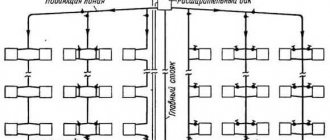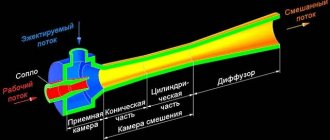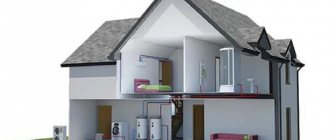The rules for the provision of utility services to owners and users of premises in apartment buildings and residential buildings, approved by the RF PP dated 05/06/2011 No. 354 (hereinafter referred to as Rules 354), provide for different procedures for calculating the cost of heating depending on the presence/absence of a common house heat metering device (CHD). energy. This article discusses changes in the calculations of heating costs associated with the commissioning of heat energy production units for various methods of payment for heating.
Payment options
Note: an article “New procedure for paying for heating” was previously published on the AKATO website (date of publication: 07/27/2016), containing clarifications, some of which have now lost their relevance (due to amendments made by the Russian Federation GD dated 02/27/2017 No. 232). This publication analyzes the norms that were relevant on the date the article was posted on the website (02/26/2018).
First of all, it is necessary to recall that Rules 354 establish 6 options for calculating the cost of heating the premises of an apartment building (hereinafter - MKD) - depending on the chosen method of payment for heating and the presence/absence of common building and individual heat energy meters (hereinafter - OPU and IPU).
Let's present these options in table form:
| Presence/absence of metering devices | Payment during the heating season | Payment evenly throughout the year |
| There is no thermal energy control unit in MKD | Payment is made according to consumption standards Formula 2 Appendix 2 of Rule 354: Pi = Si × NT × TT, where: Si is the total area of the i-th room of the apartment building (or the total area of the residential building); NT is the consumption standard for heating utility services; TT is a tariff for thermal energy established in accordance with the legislation of the Russian Federation. | Payment is made according to consumption standards, taking into account the frequency coefficient Formula 2.1 of Appendix 2 of Rule 354: Pi = Si × (NT × K) × TT, where: Si is the total area of the i-th room of the apartment building (or the total area of the residential building); NT is the consumption standard for heating utility services; K is the coefficient of frequency of payments by consumers for heating utility services, determined by dividing the number of full months of the heating period in a year by the number of calendar months in a year; TT is a tariff for thermal energy established in accordance with the legislation of the Russian Federation. |
| The MKD is equipped with a control room, not all premises of the MKD are equipped with an IPU | The actual consumed volume of heat energy (according to the operating plan) is distributed among all owners of the premises in proportion to the area of the premises owned Formula 3 Appendix 2 of Rule 354: where: VD is the volume (quantity) of thermal energy consumed during the billing period, determined according to the readings of the thermal energy control unit with which the MKD is equipped; Si is the total area of the i-th room of the apartment building; Sob - the total area of all residential and non-residential premises in the apartment building; TT is a tariff for thermal energy established in accordance with the legislation of the Russian Federation. | Payment is made based on the average monthly consumption volume for the previous year. In the first quarter of the year following the accounting year, an adjustment is made 1) Formula 3.1 of Appendix 2 of Rule 354: Pi = Si × VT × TT, where: Si is the total area of the i-th room of the apartment building; VT - the average monthly volume of thermal energy consumption for heating for the previous year, defined as the ratio of the volume of thermal energy based on the readings of the thermal energy control unit with which the apartment building is equipped for the previous year to the number of calendar months in the year and to the total area of all residential and non-residential premises in MKD. In the absence of readings from a common house meter for the previous year, the average monthly volume of thermal energy consumption is determined based on the consumption standard for the heating utility service; TT is a tariff for thermal energy established in accordance with the legislation of the Russian Federation. 2) In the first quarter of the year following the billing year, the heating fee is adjusted according to formula 3.2: , where: Pk.pr - the amount of payment for thermal energy, determined based on the readings of the operating control established in the MKD; Si is the total area of the i-th room of the apartment building; Sob - the total area of all residential and non-residential premises in the apartment building; Pfn.i - the total amount of payment for utility services for heating in the i-th residential or non-residential premises in an apartment building for the past year. |
| The MKD is equipped with a control room, all premises of the MKD are equipped with an IPU | The cost of heating consists of two components: individual consumption (determined by IPU) and general house consumption (the difference in readings between the OPU and the amount of IPU, distributed among all owners of premises in proportion to the area) Formula 3.3 of Appendix 2 of Rule 354: , where: Vin is the volume (quantity) of thermal energy consumed during the billing period in the i-th room of the apartment building, determined according to the readings of the IPU in the i-th room; ViODN - the volume (quantity) of thermal energy provided for the billing period in an apartment building equipped with a thermal energy control unit, with the exception of the volume (quantity) of thermal energy consumed in all residential or non-residential premises of the apartment building, which is determined by the formula: , where: VD is the volume (quantity) of thermal energy consumed during the billing period in the apartment building, determined when paying for heating utilities during the heating season according to the indications of the operating unit; Si is the total area of the i-th room of the apartment building; Sob - the total area of all residential and non-residential premises in the apartment building; TT is a tariff for thermal energy established in accordance with the legislation of the Russian Federation. | The cost of heating consists of two components: the average monthly individual consumption for the previous year (determined by the IPU) and the average monthly general household consumption for the previous year (the difference in readings between the GPU and the amount of the IPU, distributed among all owners of the premises in proportion to the area) 1) Formula 3.3 of Appendix 2 of Rule 354: , where: Vin is the volume (quantity) of thermal energy consumed during the billing period in the i-th room of the apartment building, determined based on the average monthly volume of thermal energy consumption for heating in the i-th room according to the readings of the IPU for the previous year; ViODN - the volume (quantity) of thermal energy provided for the billing period in an apartment building equipped with a thermal energy control unit, with the exception of the volume (quantity) of thermal energy consumed in all residential or non-residential premises in an apartment building, which is determined by the formula: , where: VD is the volume (quantity) of thermal energy consumed during the billing period in the apartment building, determined on the basis of the average monthly volume of thermal energy consumption for heating in an apartment building according to the testimony of the operational control unit for the previous year; Si is the total area of the i-th room of the apartment building; Sob - the total area of all residential and non-residential premises in the apartment building; TT is a tariff for thermal energy established in accordance with the legislation of the Russian Federation. 2) In the first quarter of the year following the billing year, the heating fee is adjusted according to formula 3.4: Pi = Pkpi − Pnpi, Where: Pkpi - the amount of payment for thermal energy consumed over the past year in the i-th residential or non-residential premises in an apartment building, determined by formula 3(3) based on the readings of an individual or common (apartment) meter in the i-th residential or non-residential premises and readings from a collective (common house) heat meter. Pnpi is the amount of payment for thermal energy accrued over the past year to the consumer in the i-th residential or non-residential premises in an apartment building, determined by formula 3(3) based on the average monthly volume of thermal energy consumption for the previous year. |
Let us separately consider how the calculation of the cost of heating changes if there was no operational control center, but at some point it was put into operation, for two cases: when choosing a method of payment for heating during the heating period and when choosing a method of paying for heating evenly throughout the year.
How to pay for heating using a meter in an apartment
The presence of residential resource consumption meters is an excellent opportunity for significant savings. The benefit is achieved only if a number of conditions are met:
- A common house heat meter must be installed and put into operation.
- In all apartments and non-residential premises there are IPUs or distributors. If there is no meter in at least one apartment, payment is calculated solely according to the ODPU readings.
According to the amendments made to the Decree of the Government of the Russian Federation No. 354, which serves as the basis for calculating payments for thermal energy, information from individual metering devices in the presence of a common house device will be accepted from January 1, 2021. Previously, the calculation was carried out according to the standard or data obtained from the heat control unit.
Taking readings
If there is a household flow meter in each room of an apartment building, correct recording of information allows you to avoid erroneous charges or recalculations. Standard data acquisition scheme, which is applicable to most heat meters:
- There is a button on the device that switches the information accumulated by the device. To quickly move the pop-up values, you need to press with a slight delay.
- The first to be displayed is the date and time, displayed in the set format.
- This is usually followed by different temperature parameters corresponding to the inlet and outlet pipes. Functional flow meters are capable of analyzing the temperature difference and current power.
- The next indicator is energy, measured in Gcal. This data needs to be removed from the screen. There are counters that do not keep track of gigacalories, although they are extremely rare. When displaying values in kW/h, values in Gcal must be calculated taking into account that 1000 kW/h = 1 MW/h = 0.86 Gcal. If information is taken from the device in GJ, the conversion to gigacalories occurs as follows: 1 GJ = 0.24 Gcal. Below in the menu you can see the volume and flow rate of the coolant.
The control panels on all powerful certified devices operate on the same principle and, when pressing keys, they alternately provide the necessary data.
Based on the available values, an independent calculation of thermal energy is carried out, taking into account the calculation of Gcal for the billing period. This will allow you to get an amount that you can use as a guide if the readings on the receipt differ significantly. According to RF PP No. 354, the following formula applies:
Pi = (Vin + Viodn × Si / Sob) × TT
Viodn = VD - ΣVin
To calculate the amount that needs to be paid, you will need to find out the data of the common building meter, all individual devices, the area of common premises and a personal apartment. The final calculation is as follows (based on approximate data): Pi = (Vin[IPU 2Gcal] + Viodn[ODN 15Gcal] × Si [apartments-40m2] / Sob[houses-5000m2]) × TT[Tariff for Moscow - 1747, 47 rub.]
Pi=(2+15×40÷5000)×1747.47
Total: Pi=3704.64 rub.
The specified amount will have to be paid for the billing period. ADI is defined separately as the difference between the TDI and all readings of individual IPUs.
Data submission
Timely transmission of information taken from the thermal energy meter eliminates problems. The resource supplying organization sets a certain period during which information must be sent using a suitable method. The term is specified in the concluded contract.
You can submit heating meter readings in the following ways:
- When contacting the office of the utility service provider in person.
- When paying a receipt at a payment center.
- By phone.
Available options for each apartment building must be presented in the office of the heat supply organization or management company, at a stand with legal information.
Payment for heating based on consumption
If payment for heating is made during the heating period, then in the absence of the operating budget, the cost of heating is calculated based on the consumption standard (formula 2 of Appendix 2 of Rule 354, column 2 of line 2 of the table).
From the moment when the readings of the operating control unit begin to be accepted for commercial accounting, two calculation options are possible - for the case when all rooms of the house are equipped with heating control units, and for the case when not all premises are equipped with heating control units.
1. If the house is equipped with an emergency control system, and at least one room is not equipped with an emergency control system, formula 3 of Appendix 2 of Rules 354 is applied (column 2, line 3 of the table).
2. If the house is equipped with a control center and all 100% of the premises are equipped with a control device, then formula 3.3 of Appendix 2 of Rule 354 is applied (column 2, line 4 of the table).
It should be noted that the date of commissioning of the control unit may not coincide with the date from which the readings of the control unit are taken into account for the purpose of calculating the cost of consumed heat energy. If the control unit has not been put into operation since the beginning of the month, it seems unacceptable to use the amount of heat measured by such a device and consumed during part of the month. In this case, it is necessary to use the meter readings from the first day of the month following the month the device was put into operation.
Formulas for calculating the cost of heating, in which the readings of the operational control unit are used, contain the volume of heat energy consumption determined exclusively for the billing period, and in accordance with paragraph 37 of Rules 354 “The billing period for paying for utilities is set equal to a calendar month.”
Thus, if a metering device is not put into operation on the first day of the month, correct use of the metering device readings in calculations is possible only when using measurements of the device taken from the first day of the month following the month the control unit was put into operation.
The most important thing that needs to be noted for the case of commissioning of the heat energy production facility when choosing a method of payment for heating during the heating period: in this case, the cost of heating is calculated in a different way from the first day of the month following the month the heat energy production facility was put into operation (or from the moment of commissioning of the heat energy production facility into operation if such commissioning was made on the first day of the month).
Payment for heating evenly throughout the year
If payment for heating is made evenly throughout the year, then in the absence of an operating budget, the cost of heating is calculated based on the consumption standard, taking into account the frequency coefficient (formula 2.1 of Appendix 2 of Rule 354, column 3 of line 2 of the table).
From the moment when the readings of the operating control unit begin to be accepted for commercial accounting, two calculation options are possible - for the case when all rooms of the house are equipped with heating control units, and for the case when not all premises are equipped with heating control units.
1. If the house is equipped with a control unit, and at least one room is not equipped with a control unit, formulas 3.1 (volume of consumption per month) and 3.2 (adjustment amount) of Appendix 2 of Rule 354 (column 3, line 3 of the table) are applied.
2. If the house is equipped with a control unit and all 100% of the premises are equipped with an automatic control unit, then formulas 3.3 (volume of consumption per month) and 3.4 (amount of adjustment) of Appendix 2 of Rule 354 (column 3, line 4 of the table) are applied.
It is necessary to note that when paying for heating evenly throughout the year, the calculation formulas contain the average monthly volume of heat energy consumption for the previous year. Such a volume can be determined based on the readings of the operational control unit (and the information control room - in the case of the installation of an information control system for all premises of the house), however, in the case of the introduction of the operational control unit into operation (that is, in the absence of the operational control unit in the previous year), it is impossible to determine the average monthly consumption volumes using metering devices. According to the commentary to formula 3.1 of Appendix 2 of Rule 354 “In the absence of readings from a common house meter for the previous year, the average monthly volume of thermal energy consumption is determined based on the consumption standard for the heating utility service.”
The most important thing that needs to be noted for the case of commissioning of the operating unit when choosing a method of payment for heating evenly throughout the year: in this case, the cost of heating charged to consumers does not change after the commissioning of the operating unit. The actual volume of heat energy consumption determined according to the operating instructions is used to adjust the heating fee and to calculate the average monthly volume of consumption in the next heating period.
How should heating in an apartment be paid for if there is an individual meter and no communal meter?
42(1).
Payment for heating utilities is carried out in one of two ways - during the heating period or evenly throughout the calendar year. In the absence of a collective (common house) heat energy meter in an apartment building, as well as an individual heat energy meter in a residential building, the amount of payment for utility heating services is determined according to formulas 2 and 2 (1) of Appendix No. 2 to these Rules based on the consumption standard heating utility services.In an apartment building that is equipped with a collective (community) heat energy meter and in which not all residential or non-residential premises are equipped with individual and (or) common (apartment) heat energy meters (distributors), the amount of payment for utility services for heating in the premises determined by formulas 3, 3 (1) and 3 (2) of Appendix No. 2 to these Rules based on the readings of a collective (common house) heat energy meter.
In an apartment building that is equipped with a collective (community) heat energy meter and in which all residential and non-residential premises are equipped with individual and (or) common (apartment) heat energy meters (distributors), the amount of payment for utility services for heating in the premises is determined according to formulas 3 (3) and 3 (4) of Appendix No. 2 to these Rules based on the readings of individual and (or) common (apartment) heat energy meters and the readings of a collective (common house) heat energy meter.
When choosing a method of payment for heating utilities during the heating period with an open heat supply system (hot water supply), if the heat metering unit of an apartment building is equipped with a collective (common house) heat energy meter that takes into account the total volume (quantity) of heat energy consumed for the needs of heating and hot water supply, to determine the amount of payment for heating utilities in accordance with the provisions of paragraphs three and four of this paragraph, the volume (quantity) of thermal energy consumed during the billing period for heating needs, during the heating period is determined as the difference in volume ( quantity) of thermal energy consumed during the billing period, determined according to the readings of the collective (common building) thermal energy meter with which the apartment building is equipped, and the product of the volume (quantity) of thermal energy consumed during the billing period, used to heat water for the purpose of providing public hot water services water supply, determined based on the standard consumption of thermal energy used to heat water for the purpose of providing public services for hot water supply, and the volume (quantity) of hot water consumed in residential and non-residential premises of an apartment building and for general house needs.
When choosing a method of payment for heating utilities during the heating period, if, with an open heat supply (hot water supply) system in an apartment building, collective (common house) metering devices are installed separately in the heating system and in the hot water supply system, the amount of payment for utility services according to heating is determined in accordance with the provisions of paragraphs three and four of this paragraph.
The amount of payment for utility services for heating in a residential building, which is equipped with an individual heat energy meter, is determined by formula 3 (5) of Appendix No. 2 to these Rules based on the readings of the individual heat energy meter.









